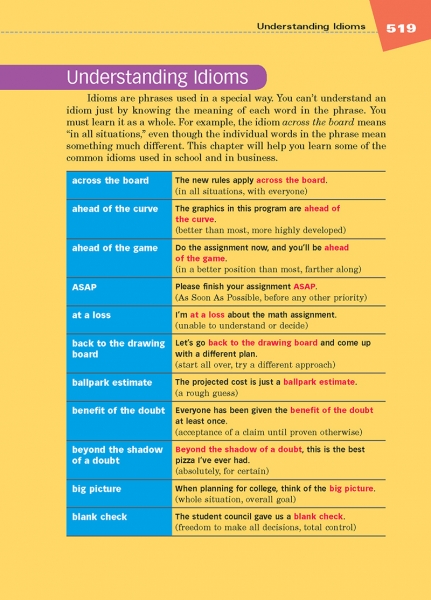Page 519 from

Start-Up Activity
Share with students the origin of the word idiom. It comes from the Latin word idioma, which means "private property." An idiom is a peculiar phrase that a group has made its own.
Then ask students to share school-appropriate idioms that they know that adults probably don't. For example, the phrase throw shade means "say something disparaging about someone." After a few students have shared idioms, ask them how they think the idiom came into being. Point out that idioms allow those who are "in" to communicate without allowing others to understand. In fact, as soon as adults understand a teenage idiom, young people will stop using it and invent something else.
That's why it's important to learn the idioms of whatever subculture a person plans to join. The idioms in this chapter work largely in the worlds of business and academics, helping students prepare for success in college and career.
Think About It
“Each person is an idiom unto himself, an apparent violation of the syntax of the species.”
—Gordon W. Allport

Start-Up Activity
Share with students the origin of the word idiom. It comes from the Latin word idioma, which means "private property." An idiom is a peculiar phrase that a group has made its own.
Then ask students to share school-appropriate idioms that they know that adults probably don't. For example, the phrase throw shade means "say something disparaging about someone." After a few students have shared idioms, ask them how they think the idiom came into being. Point out that idioms allow those who are "in" to communicate without allowing others to understand. In fact, as soon as adults understand a teenage idiom, young people will stop using it and invent something else.
That's why it's important to learn the idioms of whatever subculture a person plans to join. The idioms in this chapter work largely in the worlds of business and academics, helping students prepare for success in college and career.
Think About It
“Each person is an idiom unto himself, an apparent violation of the syntax of the species.”
—Gordon W. Allport